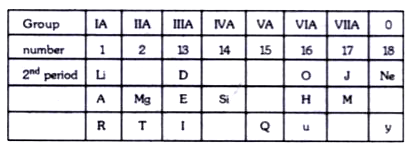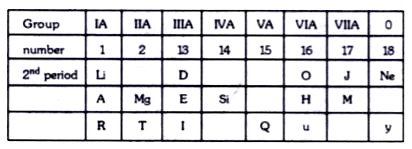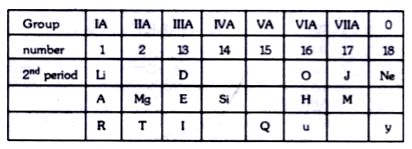Complete Solutions to QUESTIONS FOR PRACTICE ON EXAMINATION PATTERN (SECTION II) of chapter PERIODIC PROPERTIES OF ELEMENTS of Class 10 book with complete answers and questions
| Class 10 | CHEMISTRY |
| Chapter | PERIODIC PROPERTIES OF ELEMENTS |
| AVICHAL PUBLICATION | QUESTIONS FOR PRACTICE ON EXAMINATION PATTERN (SECTION II) |
| Number Of Questions | 70 |
| Academic Year | 2023-24 |
Name the first and last element in period 2
View SolutionThe following questions refer to the periodic table. Answer them carefully.
What happens to the atomic size of elements moving from top to bottom of a group?
View SolutionThe following questions refer to the Periodic Table :
Which of the elements has the greatest electron affinity among the halogens ?
View SolutionWhat is the common feature of the electronic configurations of the elements in group 17[VIIA]
View SolutionIf an element has a low ionization energy then it is likely to be _______ [`"metallic"// "non-metallic"]
View SolutionIf an element has seven electrons in its outermost shell then it is likely to have the _____ [largest/smallest] atomic size among all the elements in the same period.
View SolutionThe metals of group-2 from top to bottom are Be, Mg, Ca, Sr, Ba. Which of these metals will form ions most readily and why?
View SolutionWhat property of an element is measured by electronegativity.
View SolutionLook at the atomic radii of some elements of the second period and answer the questions.

Are these elements arranged on the pattern of a period of the periodic table?
View SolutionLook at the atomic radii of some elements of the second period and answer the questions.

Arrange these elements in the decreasing order of their atomic radii.
View SolutionLook at the atomic radii of some elements of the second period and answer the questions.

Which element has the largest atomic radius and which one has the smallest?
View SolutionName one other element for each which is in the same group as
(i) carbon (ii) fluorine (iii) sodium
View SolutionIf the element with atomic number 18 is a noble gas, to which group do you expect the elements with atomic numbers 17 and 19 belong?
View SolutionThe atomic number of helium is 2 and the atomic number of lithium is 3. Is it possible to have an element with atomic number 2.5?
View SolutionFrom the electronic configurations Na (2, 8, 1), Mg (2, 8, 2) and Al (2, 8, 3), answer the following questions:
What is the number of valence electrons in each element?
View SolutionFrom the electronic configurations Na (2, 8, 1), Mg (2, 8, 2) and Al (2, 8, 3), answer the following questions:
Assign the periods to each element in the periodic table.
View SolutionFrom the electronic configurations Na (2, 8, 1), Mg (2, 8, 2) and Al (2, 8, 3), answer the following questions:
Which element is the most reactive?
View SolutionFrom the electronic configurations Na (2, 8, 1), Mg (2, 8, 2) and Al (2, 8, 3), answer the following questions:
Which element is the least reactive?
View SolutionFrom the electronic configurations Na (2, 8, 1), Mg (2, 8, 2) and Al (2, 8, 3), answer the following questions:
Which element has the largest atomic radius?
View SolutionAn element belongs to group 17 and period 3 of the periodic table. Write the following:
The number of valence electrons in its atom.
View SolutionAn element belongs to group 17 and period 3 of the periodic table. Write the following:
Its valency.
View SolutionAn element belongs to group 17 and period 3 of the periodic table. Write the following:
Its metallic and nonmetallic nature
View SolutionAn element belongs to group 17 and period 3 of the periodic table. Write the following:
Its electronic configuration.
View SolutionComplete the given table :

View SolutionAn element X of group 15 and period 2 exists as diatomic molecule. It combines with hydrogen and forms ammonia in the presence of a suitable catalyst.
Identify the element X.
View SolutionAn element X of group 15 and period 2 exists as diatomic molecule. It combines with hydrogen and forms ammonia in the presence of a suitable catalyst.
Write the electronic configuration of X and count the number of valence electrons.
View SolutionAn element X of group 15 and period 2 exists as diatomic molecule. It combines with hydrogen and forms ammonia in the presence of a suitable catalyst.
Draw the electron dot structure of the diatomic molecule, and identify and name the type of bond formed.
View SolutionAn element X of group 15 and period 2 exists as diatomic molecule. It combines with hydrogen and forms ammonia in the presence of a suitable catalyst.
Draw the electron dot structure of ammonia.
View SolutionWhat is the total number of covalent bonds in a molecule of ammonia?
View SolutionIn group 1 of the periodic table three elements X, Y and Z have atomic radii 133 pm, 95 pm and 65 pm respectively. Giving a reason, arrange them in the order of increasing atomic number in the group.
View SolutionFrom each of the following sets, name the element with characteristics specified below:

View SolutionFrom the electronic configurations Li (2, 1), Na (2, 8, 1) and K (2, 8, 8, 1), answer the following questions:
What is the valence shell of element K?
View SolutionFrom the electronic configurations Li (2, 1), Na (2, 8, 1) and K (2, 8, 8, 1), answer the following questions:
What is the period of Na in the periodic table?
View SolutionFrom the electronic configurations Li (2, 1), Na (2, 8, 1) and K (2, 8, 8, 1), answer the following questions:
Which of these elements has the largest atomic radius?
View SolutionFrom the electronic configurations Li (2, 1), Na (2, 8, 1) and K (2, 8, 8, 1), answer the following questions:
Which one is the most reactive?
View SolutionFrom the electronic configurations Li (2, 1), Na (2, 8, 1) and K (2, 8, 8, 1), answer the following questions:
Formula of sodium sulphate is `Na_2SO_4`. Write the formula of potassium sulphate.
View SolutionState the following:
How do the atomic radii change in a period with increasing atomic number?
View SolutionState the following:
How does metallic character change in a period on moving from left to right?
View SolutionFrom the electronic configurations N (2,5), O (2,6) and F (2,7), answer the following questions:
Which one of N, O and F is most electronegative?
View SolutionFrom the electronic configurations N (2,5), O (2,6) and F (2,7), answer the following questions:
What is the number of valence electrons of F?
View SolutionFrom the electronic configurations N (2,5), O (2,6) and F (2,7), answer the following questions:
What is the period number of O in the periodic table?
View SolutionFrom the electronic configurations N (2,5), O (2,6) and F (2,7), answer the following questions:
What is the valency of each one of N, O and F?
View SolutionFrom the electronic configurations N (2,5), O (2,6) and F (2,7), answer the following questions:
Which one has the largest atomic radius?
View SolutionAtomic symbols of the first 20 elements of the periodic table are jumbled.
Rearrange these elements in the increasing order of their Elements atomic numbers
View SolutionAtomic symbols of the first 20 elements of the periodic table are jumbled up in a circle.

Arrange these elements in their correct periods.
View SolutionAtomic symbols of the first 20 elements of the periodic table are jumbled up in a circle.
View SolutionIn a period if the atomic radius of the first element is 152 pm, what is the atomic radius of the third element-more than or less than 152 pm?
View SolutionIn a period if the atomic radius of the first element is 152 pm, what is the atomic radius of the third element-more than or less than 152 pm?
View SolutionWhich one of the figures I and II represents the correct measure of atomic radius (r)?
View SolutionConsider the section of the periodic table given below.

Note : In this table B does not represent boron
C does not represent carbon
F does not represent fluorine
H does not represent hydrogen
K does not represent potassium
You must see the position of the element in the periodic table.
Some elements are given in their own symbol and position in the periodic table, while others are shown with a letter. With reference to the table:
Which is the most electronegative ?
View SolutionConsider the section of the periodic table given below.

Note: In this table, B does not represent boron
C does not represent carbon
F does not represent fluorine
H does not represent hydrogen
K does not represent potassium
You must see the position of the element in the periodic table.
Some elements are given in their own symbol and position in the periodic table, while others are shown with a letter. With reference to the table:
How many valence electrons are present in G?
View SolutionConsider the section of the periodic table given below.
Note: In this table, B does not represent boron
C does not represent carbon
F does not represent fluorine
H does not represent hydrogen
K does not represent potassium
You must see the position of the element in the periodic table.
Some elements are given in their own symbol and position in the periodic table, while others are shown with a letter. With reference to the table:
Write the formula of the compound between B and H.
View SolutionConsider the section of the periodic table given below.
Note: In this table, B does not represent boron
C does not represent carbon
F does not represent fluorine
H does not represent hydrogen
K does not represent potassium
You must see the position of the element in the periodic table.
Some elements are given in their own symbol and position in the periodic table, while others are shown with a letter. With reference to the table:
In the compound between F and J, what type of bond will be formed?
View SolutionConsider the section of the periodic table given below.

Note: In this table, B does not represent boron
C does not represent carbon
F does not represent fluorine
H does not represent hydrogen
K does not represent potassium
You must see the position of the element in the periodic table.
Some elements are given in their own symbol and position in the periodic table, while others are shown with a letter. With reference to the table:
Draw the electron dot structure for the compound formed between C and K.
View SolutionThe elements of one short period of the periodic table are given below in order from left to right:
Li Be B C O F Ne
Which one of the above elements belongs to the halogen series?
View SolutionThe elements of one short period of the Periodic Table are given below in the order from left to right:
`"Li Be B C O F Ne"`
One element of this period is missing. Which is the missing element and where should it be placed ?
View SolutionThe elements of one short period of the periodic table are given below in order from left to right:
Li Be B C O F Ne
Which one of the elements in this period shows the property of catenation?
View SolutionThe elements of one short period of the periodic table are given below in order from left to right:
Li Be B C O F Ne
Place the three elements fluorine, beryllium and nitrogen in the order of increasing electronegativity.
View SolutionThe elements of one short period of the periodic table are given below in order from left to right:
Li Be B C O F Ne
Which one of the above elements belongs to the halogen series?
View SolutionUse the letters only written in the periodic table given below to answer the questions that follow.
State the number of valence electrons in the atom of element J.

View SolutionUse the letters only written in the Periodic Table given below to answer the questions that follow :

Which element shown forms ions with a single negative charge ?
View SolutionUse the letters only written in the periodic table given below to answer the questions that follow.
Which metallic element is more reactive than element R?

View SolutionUse the letters only written in the periodic table given below to answer the questions that follow.
Which element has its electrons arranged in four shells?

View SolutionConsider a part of the periodic table of elements

• In this table H does not represent hydrogen.
• Some elements are given in their own symbol and position in the periodic table while others are shown by letters. With reference to the table answer the following questions.
Identify the most electronegative element.
View SolutionConsider a part of the periodic table of elements

• In this table H does not represent hydrogen.
• Some elements are given in their own symbol and position in the periodic table while others are shown by letters. With reference to the table answer the following questions.
Identify the most electronegative element.
View SolutionConsider a part of the periodic table of elements

• In this table H does not represent hydrogen.
• Some elements are given in their own symbol and position in the periodic table while others are shown by letters. With reference to the table answer the following questions.
Identify the element of period 3 with least atomic size.
View Solution
• In this table H does not represent hydrogen.
• Some elements are given in their own symbol and position in the periodic table.
• While others are shown with a letter.
With reference to the table answer the following questions :
Which element from group 2 would have the least ionization energy?
View SolutionConsider a part of the periodic table of elements

• In this table H does not represent hydrogen.
• Some elements are given in their own symbol and position in the periodic table while others are shown by letters. With reference to the table answer the following questions.
How many valence electrons are present in Q?
View Solution
• In this table H does not represent hydrogen.
• Some elements are given in their own symbol and position in the periodic table.
• While others are shown with a letter.
With reference to the table answer the following questions :
Identify the noble gas of the fourth period.
View Solution
• In this table H does not represent hydrogen.
• Some elements are given in their own symbol and position in the periodic table.
• While others are shown with a letter.
With reference to the table answer the following questions :
In the compound between A and H what type of bond would be formed and give the molecular formula for the same.
View Solution
QUESTIONS FOR PRACTICE ON EXAMINATION PATTERN (SECTION II) questions and complete solutions for chapter PERIODIC PROPERTIES OF ELEMENTS of EVERGREEN CHEMISTRY (ENGLISH) of Class 10
All Exercises from AVICHAL PUBLICATION Class 10 CHEMISTRY PERIODIC PROPERTIES OF ELEMENTS
- EXAMPLES
- ILLUSTRATIVE ASSIGNMENTS
- IMPORTANT ASSIGNMENTS
- QUESTION
- QUESTION (Fill in the blanks from the choices given in the brackets.)
- QUESTION FOR PRACTICE
- QUESTIONS FOR PRACTICE ( Fill in the blanks by using correct word/term given in the brackets and rewrite the complete sentence in your notebook.)
- QUESTIONS FOR PRACTICE (Answer the questions in one word or in one sentence:)
- QUESTIONS FOR PRACTICE (Choose true and false statements:)
- QUESTIONS FOR PRACTICE (Select the correct answer from the given choices (a), (b), (c) and (d).)
- QUESTIONS FOR PRACTICE ON EXAMINATION PATTERN (SECTION I (Select the correct answers from the given choices A, B, C, D. Write down only the letter corresponding to the correct answer.))
- QUESTIONS FOR PRACTICE ON EXAMINATION PATTERN (SECTION I)
- QUESTIONS FOR PRACTICE ON EXAMINATION PATTERN (SECTION II)